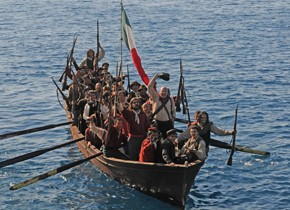La Storia
Visions of Italian History
May 12 to June 19, 2011
Thanks to the patriotic unification as a result of the “Risorgimento,” the year 1861 marks the first time since ancient Rome that a national entity called “Italia” existed on a map. The seizure of Rome and Italy's adoption of the city as the capital in 1870/71, along with several pan-national movements that followed, continued a process that was only completed – if at all – after the end of World War I in 1918. Today, one hundred and fifty years since its founding as a nation, Italy is still in a somewhat fragile state.
In the first session of the newly formed Italian Parliament, conservative politician and writer Massimo d’Azeglio is reported to have said that although there was now an Italian state, its residents, the Italians, still needed to be created. This task also fell to the Italian cinema – as a powerful setting for the heroic or skeptical, affirmative or revisionist construction of historical images and for the highly contradictory process of self-discovery.
The retrospective La Storia attempts to trace these developments through a selection of thirty-two exemplary films. Canonized masterpieces such as Roberto Rossellini’s Paisà, Vittorio Cottafavi’s Fiamma che non si spegne, Luchino Visconti’s Il gattopardo and Dino Risi’s Una vita difficile are presented alongside major discoveries such as Giacomo Gentilomo’s 'O sole mio! (1945), Gianfranco De Bosio’s Il terrorista (1963) and Paolo Benvenuti’s Segreti di stato (2003); epic productions like Bernardo Bertolucci’s 1900 and Mario Martone’s Noi credevamo are accompanied by ruminations on the Italian national character such as Camillo Mastrocinque’s outstanding comedy starring Totò, Siamo uomini o caporali? and Elio Petri’s disturbingly sinister Todo modo. The key criterion in the selection was each film’s willingness to actively conceptualize history: these works look backwards in order to present the past as historically significant – and it is self-evident that each of them also created a contemporary picture of their own moment in time.
This approach is most pointedly visible in Bertolucci’s Strategia del ragno and Benvenuti’s Segreti di stato, both of which deal with attempts at (and the limits of) historical reconstruction, and thus address the telling of history itself. But no rule without exception – as, for example, in two films about the politics of tension and terrorism in the 1970s: Marco Bellocchio’s Buongiorno, notte (2003) should not be understood as a realistic representation of the Aldo Moro kidnapping, and Todo modo (1976) is a vision of the future, filled with fury at the realization of a corrupt past and present. In some cases, the historical setting of the films is very recent: Paisà (1946) dramatizes events of the years immediately preceding the film's completion, and Una vita difficile (1961) ends at a point that coincides with its own creation. Rossellini and Risi told these stories so that future generations could study them as chronicles of the period.
Some historical processes and markers, often just moments in time, ultimately prove to be extremely attractive and powerful as far as their cinematic representations are concerned: Italian films have returned to these events again and again, while others seem to be almost fully absent from the cinematic imaginary. La Storia, therefore, does not attempt to tell an unbroken history of Italy from the Risorgimento to the present, but instead focuses on key moments which are usually considered from
several perspectives, in two or more films.
The Risorgimento is a productive example. In his blockbuster 1860 (1934), Alessandro Blasetti told the story of Garibaldi's campaign as a fascist creation myth, with Mussolini acting as the fulfillment of a long-standing promise. Disturbingly, it took only a slight shortening of the ending to re-release the film in 1951 and make it useful for the Christian Democrats during the post-war period. On the other hand, Rossellini's Viva l'Italia (1961), made under a state contract to celebrate 100 years of the Republic, emphasized the unfinished nature of Garibaldi's mission – corresponding to a historical moment of political realignment. Noi credvamo (2010), finally, shows the Risorgimento as a grandiose and inevitable abortion: Mario Martone repeatedly dramatizes the antagonisms between the barely manageable factions and demonstrates how noble ideas fail because of special interests. Which also turns it into a film about the Berlusconi era and its notions of history, as a clarion call to a divided left.
Other examples of this principle are the "doubles" about the Neapolitan uprising of September 27-30, 1943 ('O sole mio! and Nanni Loy's Le quattro giornate di Napoli), or about the circumstances of Salvatore Giuliano’s death in 1950 and the May 1, 1947 massacre at Portella della Ginestra (Segreti di stato and Francesco Rosi's Salvatore Giuliano), but also the series of films about Italy’s participation in "The Great War," 1915-1918. They are all threads of an unfinished fabric that cannot claim to represent any definitive version of Italian history. La Storia, therefore, functions as a kind of mosaic, a wealth of motifs, strands and references that are developed from film to film, without closure or promises of historical reassurance. Only in this sense can the retrospective be compared to Italy itself – or to any nation state, for that matter.
The program has been curated by Olaf Möller, with the support of the Italian Cultural Institute in Vienna, the Cineteca Nazionale in Rome, and many other Italian film archives.
